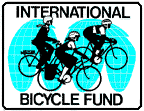Guinea: Bicycle Tour Travel Guide

![]() IBF is 100%
IBF is 100%
solar powered
![]()
by David Mozer
[An introduction and overview to travel in Africa is available by clicking here. If you are look for a bicycle tour to this country, this link might help you.]
The information below may have been extracted from a more comprehensive "Country Supplement" to the book "Bicycling In Africa". For information on these publications click on the links.
Guinea has few sandy beaches, but a great deal of cultural, historical, topographic and environmental diversity that can hold the attention of the visitor. Though its history is not particularly accessible at the moment, Guinea is integrally involved in the history of West Africa from the time of the grassland empires, through the Atlantic slave trade, colonialism, the fight for modern statehood and its course as an independent state. The motivated visitor can stay engaged tracing this history.
Routes
Cycling to Mamou you will find a good paved road. From Mamou the pavement continues to the north to Dalaba, Pita and Labe. To the east there is pavement to Dabola, Bissikrima and Kouroussa. And to the southeast roads are paved to Faranah, Kissidougou and Guekedou. The road from Kissidougou to Kankan was once paved. And closer to Conakry the spurs to Forecariah and Boke are also tarmac.
From the main system of paved truck roads there is an extended system of dirt (combinations of clay and gravel) primary and secondary roads. There is no correlation between the designation as primary or secondary and the quality of the dirt roads. If you had to define a relationship it might be the inverse of what you would assume -- secondary dirt roads are often better than the primary dirt roads. This can be explained by the fact that secondary roads have less traffic and the vehicles are often lighter.
Near the coast it is hot and humid. As you work your way inland it is drier -- whether the temperature is hotter or cooler depends upon the elevation and the season.
The following generalizations can be made about the regions of the country and routes:
- Basse Cote Guinea (Maritime) is characterized by greenness and rolling coastal plains. The are no easily identifiable loops in this region. To make a loop that doesn't include minor tracks you need to include at least the western edge of the Futa Jalon region.
- Moyenne Guinea (Futa Jalon) features large hills, mountains and flatter high plains, mile after mile of beautiful vistas and a cooler climate than the rest of the country. (They burn large sections of the grassland plains during the dry season, which leaves them blackened and less scenic for part of the year.) Here is where you can create loops. There are so many opportunities for interesting and scenic loops that it would be difficult to list all the possible combinations of routes. In addition to the paved roads, the roads from Dalaba to Tougue and from the Telimele road to Pita are in good condition. The roads from Kandia to Telimele and Labe to Tougue and points beyond Telimele, Labe and Tougue are not in good condition, but they are still rideable (services are generally more scarce so you will want to be fairly self-sufficient).
- Haute Guinea (Eastern Savannah) is flat east of Dabola. The region has the beauty of the Sahel and some of the towns are very interesting. In some sections town are quite spread out. You can create a loop around Mamou, Kissidougou and Kankan. This can be shortened considerably by take the road between Faranah and Dabola. There is a scarcity of services in many areas of Haute Guinea so you need to be prepared to be quite self-sufficient. Haute Guinea provides the access to and from Mali and Cote d'Ivoire (Ivory Coast).
Guinea Forestiere (Southern Forest) is cut by a lot of small rivers so the topography is hilly, generally small, but sometimes large, up and down hills. If you want to do a loop in through the forest you can go from Macenta to Nzerekore, Beyla, Konsankoro and back to Macenta. This is entirely dirt roads and only in Macenta, Nzerekore and Beyla will you find established lodging. When security in Liberia improves there will be a number of interesting loops using cross-border routes.
Links of Interest:
Regional Resources:
Cote d'Ivoire
Mali
Senegal
Sierra Leone
Liberia
For current news on Africa and more web sites with country-by-country information go to the link section and click on "Africa: News, Background, Travel."
Home | About Us | Contact Us | Contributions | Economics | Education | Encouragement | Engineering | Environment | Bibliography | Essay Contest | Ibike Tours | Library | Links | Site Map | Search
![]()
The International Bicycle Fund is an independent, non-profit organization. Its primary purpose is to promote bicycle transportation. Most IBF projects and activities fall into one of four categories: planning and engineering, safety education, economic development assistance and promoting international understanding. IBF's objective is to create a sustainable, people-friendly environment by creating opportunities of the highest practicable quality for bicycle transportation. IBF is funded by private donation. Contributions are always welcome and are U.S. tax-deductible to the extent allowed by law.
![]()
![]() Please write if you have questions, comment, criticism, praise or
additional information for us, to report bad links, or if you would like to be
added to IBF's mailing list. (Also let us know how you found this site.)
Please write if you have questions, comment, criticism, praise or
additional information for us, to report bad links, or if you would like to be
added to IBF's mailing list. (Also let us know how you found this site.)
